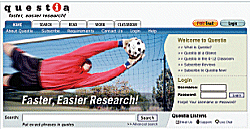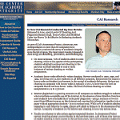Fighting Plagiarism :: Taking the Work Out of Homework
##AUTHORSPLIT##<--->
With the rise of the internet, schools are seeing an epidemicof cut-and-paste plagiarism. But the same technology that’s makingplagiarism easy is being used by teachers to catch copycats in the act.
 IT WAS ONE of those assignments that Advanced Placement English students at Oak Park High School in Ventura, CA, love to get. The students had just finished reading Aldous Huxley’s Brave New World, and their teacher, Roland Herberg, asked them to pair up and create brochures about the book. Herberg’s instructions were simple: Each brochure had to contain an essay about totalitarian tendencies in modern society, and all of the work had to be original. The rest of the design elements were up to the students; Herberg told the kids theycould be as creative as they wanted to be.
IT WAS ONE of those assignments that Advanced Placement English students at Oak Park High School in Ventura, CA, love to get. The students had just finished reading Aldous Huxley’s Brave New World, and their teacher, Roland Herberg, asked them to pair up and create brochures about the book. Herberg’s instructions were simple: Each brochure had to contain an essay about totalitarian tendencies in modern society, and all of the work had to be original. The rest of the design elements were up to the students; Herberg told the kids theycould be as creative as they wanted to be.
One pair of students, however, clearly wasn’t creative enough. Their brochure, titled “Religion Is Terrorism,” presented a fully integrated argument about the negative consequences of religion. Herberg, no stranger to the capabilities of 17-year-olds, was suspicious immediately. It’s not that the argument wasn’t strong; on the contrary, it was so sophisticated that Herberg felt it had to belong to someone else. Sure enough, when the teacher plugged the title phrase into Google, he discovered that the first half of the four-page brochure was almost completely taken from a bookon the same subject.
Herberg gave the students a C-minus on their project and confronted them. It became evident that one student was far more culpable than the other. The student became indignant when Herberg accused her of plagiarism, denying ever visiting some of the websites Herberg said he had found. Days later, when the confrontation had escalated to the counseling office, the student admitted she had plagiarized, but insisted the act was neither immoral nor unethical. To add insult to injury, the student then wrote Herberg a nasty letter, accusing him of “stiflingher creativity.” Herberg, understandably, was astounded.
“She understood it was plagiarism, but didn’t feel she had done anything wrong,” he says, still looking back on the experience with disbelief. “She had put a lot of time and effort into getting the sources from the internet. By putting all of it intoa different medium, she honestly thought it would be okay.”
Unfortunately, what happened at Oak Park is happening on campuses nationwide—plagiarism is on the rise. With veritable libraries at their fingertips, students see nothing wrong with borrowing a sentence or paragraph or page from something they find online. What’s more, the prevalence of e-mail and instant messaging makes sharing derivative material easier than ever before. On the flipside, teachers are far too busy to track down original sources unless the offense is obvious. The result is education’s own Wild West, in which ideas are stolen and repurposed without retribution, hurting those studentswho actually produce original work.
Educators are now beginning to fight back. Some, like Herberg, have assumed the role of Wyatt Earp and taken matters into their own hands, using free internet technologies to nab students in the act. Other schools have turned to vendors to help fight their battles—with solutions from companies such as iParadigms and Questia. Finally, a small group of academic experts has taken a more philosophical approach, rethinking key facets of the educational process and proposing to eliminate cheating by changing the nature of the assignments. All of the solutions have merit; the key for school district officialsis finding the one that works best.

CAUGHT! Questia offers access to what
it calls the world’s largest online library to
help educators nab student plagiarizers.
Plagiarism 101
Plagiarism essentially is a matter of deceit: fooling a reader into believing that certain written material is original when it is not. In fact, you have just witnessed an act of plagiarism: The bulk of that previous sentence was plucked straight from the Wikipedia definition of plagiarism,with no citation.
Plagiarism certainly is nothing new and not confined to K-12; over the years, dozens of famous writers have been accused of it. Earlier this year, Harvard University sophomore Kaavya Viswanathan was fingered for plagiarizing entire passages of her debut novel, How Opal Mehta Got Kissed, Got Wild, and Got a Life, from another coming-of-age romance novel by a different author. Experts, however, say the most rampant plagiarizing occurs in the K-12 environment, where students are encouraged to use the internet to source their assignments. A national survey by the Rutgers University Management Education Center (see “Guilt-Free Cheaters”) found that 60 percent of the 18,000 responding highschool students engaged in plagiarism to get ahead.
“It’s a huge problem in the K-12 space,” says Ilan Barzilay, associate at the Boston law firm Wolf, Greenfield & Sacks, which handles a variety of copyright cases. “Students just cut and paste things and turn their work in. For them, the convenience far outweighs the likelihood of getting caught.”
Students aren’t only cutting and pasting from websites; often they buy the whole package. Some sites—known as term-paper mills—offer A-plus term papers for as little as $6.95 per page. One site, SchoolSucks.com, posts papers on subjects from workplace ethics to temperance champion Francis Willard, for free. While many educators assail the site for making it easy for students to copy entire homework assignments in seconds, SchoolSucks founder Kenneth Sahr has said that the papers housed on his site are meant to be used as research material, which is a curious thing to say in light of the banner scrolled atop the site, which exclaims, “Free homework website!” Ever the public servant, Sahr has also said that the poor quality of the essays he sells should be taken by educators as a warning about the level of student our school system is producing. (Sahr did not return requests seeking comment for this story.)
Regardless of how it’s carried out, plagiarism has a number of negative consequences. For starters, it’s against the law to use copyrighted material without proper citation, and any student guilty of it technically could face legal trouble. Secondly, the act shortchanges students who do it, denying them the benefits of thinking on their own. Finally—and perhaps most troubling— Herberg says plagiarism hurts those students who actually take the time to develop their own work; when a teacher mistakenly considers a plagiarized paper to be original, the bar gets raised to the point where legitimate papers may be docked in comparison. “If a teacher reads what he perceives to be an A paper and does not detect the paper is plagiarized, all of the students who wrote A papers on their own will suffer,” Herberg says. “The greatest crime is that no matter what happens to the students who are committing plagiarism, it inevitably hurts those students who are honest and ethical.”
SMELLS LIKE TEEN PLAGIARISM
Nancy Willard, executive director of the Center for Safe and Responsible Internet Use in Eugene, OR, tells teachers to look out for these telltale symptoms of plagiarized work:
- Use of language inconsistent with the language a typical middle or high school student would use.
- Inexplicable changes in fonts, or the presence of underlined links to web pages.
- Portions of text that are formatted differently from the rest of the essay.
- Endnote or footnote annotations that do not correspond accordingly.
- A paragraph or sentence that appears in several students’ papers.
A Good Defense
As Herberg learned firsthand, the surest way to catch students in an act of plagiarism is to track down portions of their papers on the very internet whence they came. The easiest tools to use for this are Google and other popular search engines—the same websites to which students might look if they were planning on researching a project legitimately. Nancy Willard, executive director of the Center for Safe and Responsible Internet Use in Eugene, OR, says that because most students commit plagiarism out of sheer laziness, sources for a plagiarized paper generally can be found on the first three pages of a search return.
Search engines, however, are not foolproof. Because they scan only the free internet, plagiarized work from subscription- based periodicals and other term papers will not show up on a standard search. With thatin mind, many schools recently have signed up for plagiarism prevention service from iParadigms, a software company based in Oakland, CA. The service, called Turnitin, specializes in the digital assessment of student work and vets documents for originality. It works entirely through a web browser; subscribing teachers have their students upload papers directly through the website, where the papers are instantaneously compared against the Turnitin database. The database consists of a copy of the free internet, commercial content (including most major newspapers, academic journals, magazines, and periodicals), and every paper that’s ever been run through the system. According to company CEO John Barrie, a search takes seconds and delivers discreet results to educators upon demand. Each paper is color-coded to show which sections, if any, are plagiarized and where the original material is from. A copy of the paper is then sent to the teacher, who has evidence to take action.
“In the past, instructors would say, ‘I know this is not your work. Tell me where you got these words,’” explains Barrie, who says the service receives more than 50,000 to 60,000 student papers every day. “With our service, they can say, “Please explain to me why 87 percent of your work is plagiarized.’ It’sa huge difference.”
GUILT-FREE CHEATERS

STUDENT PLAGIARIZERS HAVE LITTLE REMORSE, SAYING THEY’RE SIMPLY FOLLOWING THE EXAMPLE SET BEFORE THEM.
The latest results of an ongoing national survey by the Center for Academic Integrity provide some pretty sobering facts about plagiarism in the K-12 environment.
- More than 70 percent of the 18,000 surveyed high school students admitted they had engaged in serious cheating; 60 percent admitted to plagiarism.
- More than half have plagiarized work they found on the internet.
- Most of them don’t see anything wrong with cheating.
Don McCabe, head of CAI’s survey and professor of organization management at Rutgers University, has been surveying student attitudes on cheating since 2002. He asked some of the respondents to list the reasons they cheat. McCabe told CNN he was surprised to learn that students find it easy to rationalize their cheating by saying they’re following poor examples set by their parents.
“I think kids today are looking to adults and society for a moral compass,” McCabe said. “When they see the behavior occurring there, they don’t understand why they should be held to a higher standard.”
Recent iterations of McCabe’s research have focused mainly on higher education. In 2003, for instance, the survey found that 38 percent of 18,000 college-age respondents said they had tried to pass off cut-and-pasted work from the internet as their own.
Another commercial option is offered by Questia, which bills itself as the world’s largest online library. The Questia feature isn’t a standalone service like Turnitin; instead, interested parties sign up for access to the entire Questia database, and can utilize standard search functions to scan the library for occurrences of a particular phrase. Anyone who works for a school or district that subscribes to Questia can consult the database todetect plagiarism.
Educators at Breckenridge High School in Texas put Questia technology to the test all the time, and last year, teachers in the English department managed to catch one would-be student plagiarizer. Jay Clack, chair of the department, remembers the student’s paper explicitly—a report on the loss of familyowned farms. Clack says the first few paragraphs of the paper were excellent, but the document came to a point where it did not “sound like” the student at all. Clack questioned the student and didn’t get a straight answer, so he put the passages into Questia for analysis. Sure enough, the system indicated they were lifted fromanother source.
“It makes it easy for me to track anything that is questionable, because I can enter a suspicious sentence or phrase, and Questia will lead me to the exact source of the material,” Clack says. “Because my students know that I am more likelyto check their work, I think they are less likely to plagiarize.”

BORROWER BEWARE Turnitin detects
plagiarized passages in student papers.
What’s Next
To some degree, Clack’s optimism about the efficacy of plagiarism deterrents is well founded. Since his school began using Questia, incidents of plagiarism have dropped precipitously. Barrie reports similar results from his iParadigms customers, adding that the more schools that have signed up and used Turnitin to frisk assignments for plagiarism, the larger the Turnitin database has gotten, bolstering its ability to smoke out copycats. Still, students continue to plagiarize—and get away with it. Unless school districts do something to step in and putan end to the practice, it will continue to run rampant.
One solution to the plagiarism epidemic is to fight back with education: Teach students how to source appropriately. Anthony Cody, consulting teacher with Peer Assistance and Review, a state-funded program in California to assist new and underperforming teachers, says that because a “certain degree” of copying is inherent in research, every teacher should start the school year with a lesson on what is and is not plagiarism, outlining the difference between citing a primary source and copying it, and explaining to students where the separationreally is.
“It’s a subtle distinction for a sixth-grader who does not understand why it’s acceptable to get the information but not okay to use the author’s exact words,” says Cody, who taught at Bret Harte Middle School in Oakland, CA, for 18 years before assuming his current job. “Teacherscan’t just expect students to know this stuff.”
Other educators suggest different strategies to fight plagiarism, from instituting policy that makes Google searches mandatory before grading to an SAT-like approach that requires students to write all essays in class. Doug Johnson, director of media and technology for Mankato Area Public Schools in Minnesota, offers yet another idea: changing the pedagogy so it’s impossible for students to copy at all. For Johnson, open-ended assignments are the biggest catalysts of plagiarism because the research process begs students to lift someone else’s work. By asking for a higher-order level of creativity and personalization, Johnsoninsists teachers can eliminate the threat of copycats altogether.
To explain his stance, Johnson offers an example in the social sciences. When studying the Olympics in ancient Greece, he says, most teachers would ask their students to write a report on the games and their cultural significance. A better assignment would be to have students choose their favorite athletes of today and predict how they would have performed in ancient Greece, then explain why. While the first question hinges only on research, Johnson’s approach combines research, synthesis, application, and thought. Work which incorporates that degree of originalthinking is nearly impossible to duplicate without detection.
“If you have an assignment that seems valueless, you can’t really justify kids plagiarizing, but you certainly can understand why they might,” he says. “All kids can be creative if we give them a chance, but it’s up to educators to take that leap.”
:: web extra :: For more information on this topic, visit www.thejournal.com. In the Browse by Topic menu, click onSecurity/Privacy.
Matt Villano, a writer and editor based in Half Moon Bay, CA, writes regularly for T.H.E. Journal and is a senior contributing editor to T.H.E.sister publication Campus Technology.